List of New Zealand animals extinct in the Holocene
This is an incomplete list of extinct animals of New Zealand. This list covers only extinctions from the Holocene epoch.
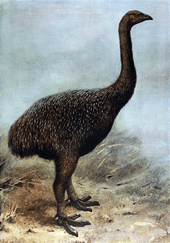
Upland moa (Megalapteryx didinus)
Mammals
Bats are the only land mammals known to have inhabited New Zealand before humans arrived. Fossil marine mammals have been found.
| Common name | Scientific name | Extinction date | Range | Image |
|---|---|---|---|---|
| Greater short-tailed bat | Mystacina robusta[1] | 1965 | New Zealand | -- |
Birds
Extinctions since 19th-century European settlement
| Common name | Scientific name | Extinction date | Range | Image |
|---|---|---|---|---|
| Auckland Islands shore plover | Thinornis rossi | 1840 | New Zealand (Auckland Islands) | 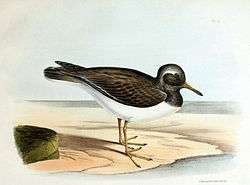 |
| Bush wren | Xenicus longipes | 1972 | New Zealand | 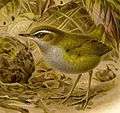 |
| Chatham bellbird | Anthornis melanocephala | 1906 | New Zealand (Chatham Islands) |  |
| Chatham fernbird | Bowdleria rufescens | 1895 | New Zealand (Chatham Islands) |  |
| Chatham Islands penguin | Eudyptes chathamensis | 1872? | New Zealand (Chatham Islands) | -- |
| Chatham Islands rail | Cabalus modestus | 1900 | New Zealand (Chatham Islands) | 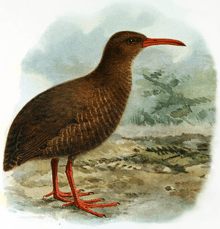 |
| Crested moa | Pachyornis australis | 1850s | New Zealand (South Island) | -- |
| Dieffenbach's rail | Gallirallus dieffenbachii | 1872 | New Zealand (Chatham Islands) | .png) |
| Finsch's duck | Chenonetta finschi | 1870 | New Zealand | -- |
| Hawkins's rail | Diaphorapteryx hawkinsi | late 19th century | New Zealand (Chatham Islands) | -- |
| Huia | Heteralocha acutirostris | 28 December 1907 | New Zealand |  |
| Laughing owl | Sceloglaux albifacies | 5 July 1914 | New Zealand | 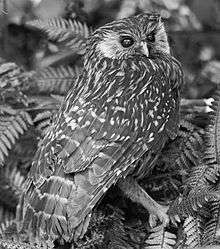 |
| Lyall's wren | Xenicus lyalli | 1894 | New Zealand | 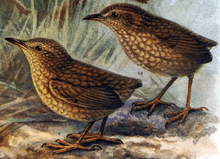 |
| Mysterious starling | Aplonis mavornata | 1774 | New Zealand (Cook Islands) | -- |
| New Zealand little bittern | Ixobrychus novaezelandiae | 1890s | New Zealand | 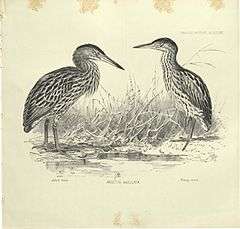 |
| New Zealand merganser | Mergus australis | 9 January 1902 | New Zealand (Auckland Islands) | 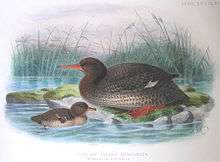 |
| New Zealand quail | Coturnix novaezelandidae | 1875 | New Zealand |  |
| North Island piopio | Turnagra tanagra | 1955 | New Zealand (North Island) | 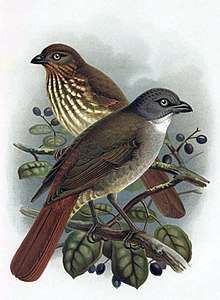 |
| North Island snipe | Coenocorypha barrierensis | 1870 | New Zealand (North Island) | 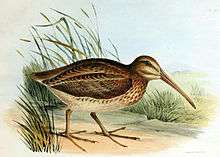 |
| North Island takahē | Porphyrio mantelli | 1894? | New Zealand (North Island) | -- |
| South Island piopio | Turnagra capensis | 1963 | New Zealand (South Island) |  |
| South Island snipe | Coenocorypha iredalei | 1960s | New Zealand (South Island) | -- |
Extinctions since Māori arrival
| Common name | Scientific name | Extinction date | Range | Image |
|---|---|---|---|---|
| Adzebill | Aptornis defossor and Aptornis otidiformis | 16th century | New Zealand | 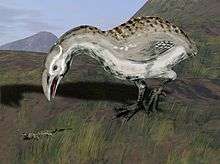 |
| Bush moa | Anomalopteryx didiformis | 15th century | New Zealand |  |
| Chatham Islands duck | Pachyanas chathamica | 17th century | New Zealand (Chatham Islands) | -- |
| Chatham raven | Corvus moriorum | New Zealand (Chatham Islands) | -- | |
| Coastal moa | Euryapteryx curtus | 16th century | New Zealand | 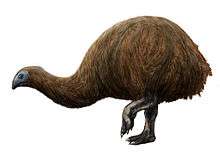 |
| Eastern moa | Emeus crassus | 16th century | New Zealand (South Island) | 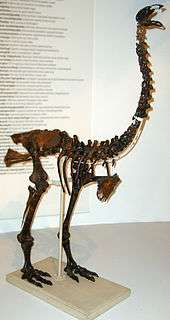 |
| Eyles's harrier | Circus eylesi | 1777 | New Zealand | -- |
| Giant moa | Dinornis sp. | 16th century | New Zealand | .jpg) |
| Haast's eagle | Hieraaetus moorei | 16th century | New Zealand (South Island) | 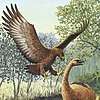 |
| Heavy-footed moa | Pachyornis elephantopus | 16th century | New Zealand (South Island) | 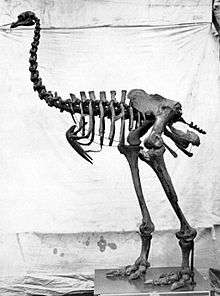 |
| Hodgen's waterhen | Gallinula hodgenorum | 16th century | New Zealand | -- |
| Long-billed wren | Dendroscansor decurvirostris | 14th century | New Zealand (South Island) | -- |
| New Zealand geese | Cnemiornis calcitrans and Cnemiornis gracilis | 16th century | New Zealand |  |
| New Zealand owlet-nightjar | Aegotheles novazelandiae | 13th century | New Zealand | -- |
| New Zealand raven | Corvus antipodum | 16th century | New Zealand | -- |
| New Zealand musk duck | Biziura delautouri | 16th century | New Zealand | -- |
| New Zealand swan | Cygnus sumnerensis | 16th century | New Zealand (South Island and Chatham Islands) | -- |
| Scarlett's duck | Malacorhynchus scarletti | 16th century | New Zealand | -- |
| Scarlett's shearwater | Puffinus spelaeus | 13th century | New Zealand (South Island) | -- |
| Snipe-rail | Capellirallus karamu | 13th century | New Zealand (North Island) | -- |
| Stout-legged wren | Pachyplichas yaldwyni | New Zealand (Chatham Islands) | ||
| Upland moa | Megalapteryx didinus | 16th century | New Zealand (South Island) | 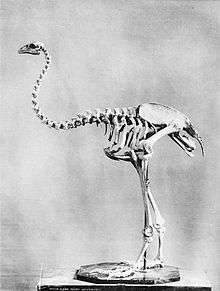 |
| Waitaha penguin | Megadyptes waitaha | 14th century[2] | New Zealand | -- |
Reptiles
- Kawekaweau, Delcourt's giant gecko, Hoplodactylus delcourti[3] 1870, New Zealand
- Narrow-bodied skink, Oligosoma gracilicorpus[4] 1955, New Zealand (North Island)
- Northland skink, Oligosoma northlandi (Late Holocene), New Zealand
Amphibians
- Aurora frog, Leiopelma auroraensis
- Markham's frog, Leiopelma markhami
- Waitomo frog, Leiopelma waitomoensis
Fish
| Common name | Scientific name | Extinction date | Range | Image |
|---|---|---|---|---|
| New Zealand grayling | Prototroctes oxyrhynchus[5] | 1930s | New Zealand | |
Insects
- Mecodema punctellum[9] 1931, New Zealand (Stephen Islands)
Molluscs
Placostylus ambagiosus priscus
- Placostylus ambagiosus gardneri Land snail, Recent
- Placostylus ambagiosus hinemoa Land snail, Recent
- Placostylus ambagiosus lesleyae Land snail, Recent
- Placostylus ambagiosus priscus Land snail, Recent
- Placostylus ambagiosus spiritus Land snail, Recent
- Placostylus ambagiosus worthyi Land snail, Recent
See also
- New Zealand geologic time scale
- Holocene extinction
- Lists of extinct animals
- List of recently extinct bird species (1500 – present)
- List of extinct plants of New Zealand
- Waipatia maerewhenua (an extinct species of whale from the Oligocene of New Zealand)
- Pleistocene New Zealand sea lion (an extinct species of sea lion from the Pleistocene of New Zealand)
- Saint Bathans mammal
- New Zealand Threat Classification System
References
- O'Donnell, C. (2008). "Mystacina robusta". IUCN Red List of Threatened Species. 2008: e.T14260A4427606. doi:10.2305/IUCN.UK.2008.RLTS.T14260A4427606.en. Retrieved 13 January 2018.
- Fox, Rebecca (20 November 2008). "Ancient species of penguin found in DNA of bones". Otago Daily Times. Archived from the original on 9 June 2011. Retrieved 20 November 2008.
- World Conservation Monitoring Centre (1996). "Hoplodactylus delcourti". IUCN Red List of Threatened Species. 1996: e.T10254A3185278. doi:10.2305/IUCN.UK.1996.RLTS.T10254A3185278.en. Retrieved 13 January 2018.
- Australasian Reptile & Amphibian Specialist Group (1996). "Oligosoma gracilicorpus". IUCN Red List of Threatened Species. 1996: e.T15266A4508504. doi:10.2305/IUCN.UK.1996.RLTS.T15266A4508504.en. Retrieved 13 January 2018.
- World Conservation Monitoring Centre (1996). "Prototroctes oxyrhynchus (New Zealand Grayling)". IUCN Red List of Threatened Species. 1996. Retrieved 29 December 2013.CS1 maint: ref=harv (link)
- Blakemore (2012). "On Schmarda's lost earthworm and some newly found New Zealand species(Oligochaeta: Megadrilacea: Lumbricidae,Acanthodrilidae, Octochaetidae, & Megascolecidae s. stricto)". Journal of Species Research. JSR. 1 (2): 105–132. doi:10.12651/jsr.2012.1.2.105.
- Blakemore (2017). "Tokea orthostichon". IUCN Red List of Threatened Species. 2017: 1. Retrieved 14 February 2019.{{cite iucn}}: error: malformed |page= identifier (help)
- Blakemore (2019). "Redescription of extinct New Zealand earthworm: Tokea orthostichon (Schmarda, 1861)" (PDF). Bull. Kanagawa Prefectural Museum (N.H.). 42: 61–68. Retrieved 1 March 2019.
- World Conservation Monitoring Centre (1996). "Mecodema punctellum". IUCN Red List of Threatened Species. 1996: e.T12922A3398669. doi:10.2305/IUCN.UK.1996.RLTS.T12922A3398669.en. Retrieved 13 January 2018.
Further reading
- Bell, B.D. 1994. A review of the status of New Zealand Leiopelma species (Anura: Leiopelmatidae), including a summary of demographic studies in Coromandel and on Maud Island. New Zealand Journal of Zoology, Vol. 21: 341–349.
- Bunce, M., Worthy, T.H., Ford, T., Hoppitt, W., Willerslev, E., Drummond A., and Cooper, A. 2003. Extreme reversed sexual size dimorphism in the extinct New Zealand moa Dinornis. Nature, 425:172–175.
- Cooper, A., Lalueza-Fox, C., Anderson, C., Rambaut, A., Austin, J., and Ward, R. 2001. Complete mitochondrial genome sequences of two extinct moas clarify ratite evolution. Nature 409:704–707.
- Day, D., 1981, The Doomsday Book of Animals, Ebury Press, London.
- Gill, B.; Martinson, P., (1991) New Zealand’s Extinct Birds, Random Century New Zealand Ltd.
- Gill, B. J. 2003. Osteometry and systematics of the extinct New Zealand ravens (Aves: Corvidae: Corvus). Journal of Systematic Palaeontology 1: 43–58.
- Flannery, T., and Schouten, P., 2001, A Gap in Nature: Discovering the World's Extinct Animals, William Heinemann, London. ISBN 0-434-00819-2 (UK edition).
- Fuller, E., 2001, Extinct Birds, Oxford University Press. ISBN 0-253-34034-9 (UK Edition).
- Holdaway, Richard N., Worthy, Trevor H. and Tennyson, Alan J. D. 2001. A working list of breeding bird species of the New Zealand region at first human contact, New Zealand Journal of Zoology, 28:119–187.
- Huynen, L., Millar, C.D., Scofield, R.P., and Lambert, D.M. 2003. Nuclear DNA sequences detect species limits in ancient moa. Nature, 425:175–178.
- Perkins, S. 2003. Three Species No Moa? Fossil DNA analysis yields surprise. Science News, 164:84.
- Philip R. Millener & T. H. Worthy (1991). "Contribution to New Zealand's late Quaternary avifauna. II: Dendroscansor decurvirostris, a new genus and species of wren (Aves: Acantisittidae)." Journal of the Royal Society of New Zealand. 21, 2: 179–200.
- Philip R. Millener (1988). "Contributions to New Zealand's late Quaternary avifauna. I: Pachyplichas, a new genus of wren (Aves: Acanthisittidae), with two new species." Journal of the Royal Society of New Zealand. 18:383–406
- Wilson, K-J, (2004) Flight of the Huia, Canterbury University Press, Christchurch. ISBN 0-908812-52-3
- World Conservation Monitoring Centre 1996. Karocolens tuberculatus. In: IUCN 2004. 2004 IUCN Red List of Threatened Species. <www.iucnredlist.org>. Downloaded on 2 March 2006.
- World Conservation Monitoring Centre 1996. Mecodema punctellum. In: IUCN 2004. 2004 IUCN Red List of Threatened Species. <www.iucnredlist.org>. Downloaded on 2 March 2006.
- Worthy, T.H. 1998. The Quaternary fossil avifauna of Southland, South Island, New Zealand. Journal of The Royal Society of New Zealand. Volume 28, Number 4, pp 537–589.
- Worthy, T.H., Holdaway R.N., 2002, The lost world of the Moa: Prehistoric Life of New Zealand, Indiana University Press, Bloomington. ISBN 0-253-34034-9.
- Worthy, T.H., et al. 2006, Miocene mammal reveals a Mesozoic ghost lineage on insular New Zealand, southwest Pacific. 103 PNAS 19419–19423.
External links
This article is issued from Wikipedia. The text is licensed under Creative Commons - Attribution - Sharealike. Additional terms may apply for the media files.